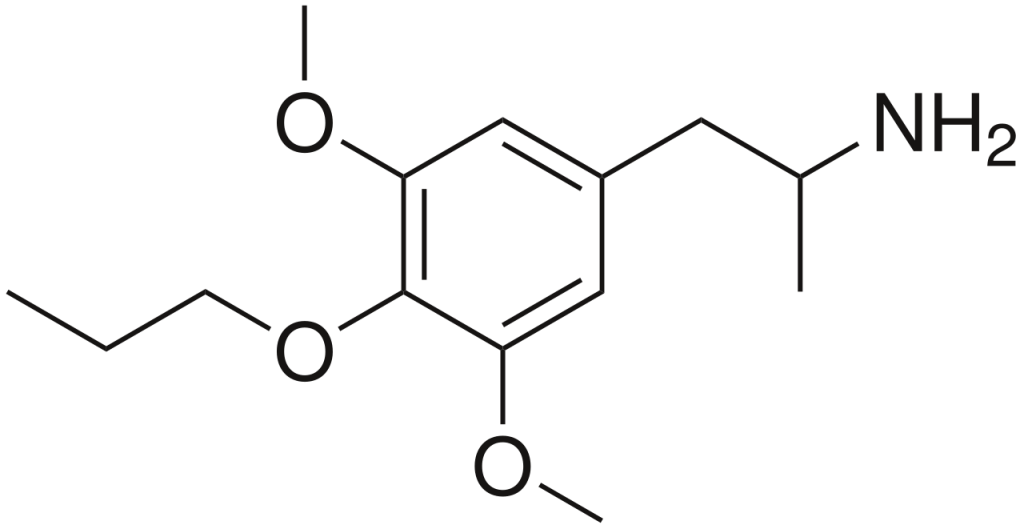Summary
3C-P, scientifically identified as α-Methyl-4-propoxy-3,5-dimethoxyphenethylamine, is classified as a psychedelic phenethylamine. This compound shares structural and pharmacodynamic characteristics with substances like mescaline, proscaline, and amphetamine.
Although limited information is available regarding the human pharmacology of 3C-P, anecdotal reports suggest that a psychedelic dosage typically falls within the range of 20 to 40 mg. When ingested at these levels, it is reported to induce a combination of stimulant and psychedelic effects, including visual enhancement and distortion.
Synthesis of 3C-P is achieved through a chemical process that begins with syringaldehyde, followed by a reaction with n-propyl iodide and subsequent condensation with nitroethane, concluding with reduction.
| Identifiers | |
|---|---|
| IUPAC name | |
| CAS Number | 501700-11-4 |
|---|---|
| PubChem CID | 54929142 |
| ChemSpider | 21106238 |
| UNII | 4KRX4MHV7L |
| Chemical and physical data | |
| Formula | C14H23NO3 |
| Molar mass | 253.342 g·mol−1 |

FAQ
1. What is 3C-P?
- 3C-P is a psychedelic compound classified as a phenethylamine known for its psychoactive effects.
2. How does 3C-P compare to other psychedelics like mescaline and amphetamine?
- 3C-P shares structural and pharmacodynamic similarities with substances such as mescaline, proscaline, and amphetamine.
3. What is the typical dosage of 3C-P?
- While the precise dosage can vary, anecdotal information suggests that a common psychedelic dosage for 3C-P is in the range of 20 to 40 mg. Please exercise caution and consult reliable sources for more accurate dosing information.
4. What effects can one expect from 3C-P use?
- 3C-P is reported to induce a combination of stimulant and psychedelic effects. Users often describe experiences of visual enhancement and distortion. However, the specific effects can differ from person to person.
5. Is 3C-P legal?
- The legal status of 3C-P varies by country and jurisdiction. It may be controlled in some regions, while in others, it might be unregulated or fall into a legal gray area. It’s important to understand the specific regulations in your area.
6. What are the potential risks associated with 3C-P use?
- Using 3C-P, like other psychedelics, carries potential risks, including psychological distress, anxiety, and other adverse effects. It is essential to consider set and setting when using this substance.
7. Can 3C-P be used for therapeutic purposes?
- There is limited research on the therapeutic potential of 3C-P, and it is not approved for medical or therapeutic use. Other psychedelics, like psilocybin and MDMA, have been more extensively studied for therapeutic applications.
8. Is 3C-P addictive?
- The addictive potential of 3C-P is not well understood, but it is generally considered to have a lower risk of physical dependence compared to substances like opioids or stimulants. Psychological dependence can still occur.
9. Where can I find more information about 3C-P?
- Given the evolving legal and scientific landscape surrounding 3C-P, it’s important to consult reliable sources of scientific literature and seek advice from healthcare professionals. Staying informed and making well-informed decisions is crucial when considering the use of this substance.
References
- Trachsel D (September 2002). “Synthese von neuen (Phenylalkyl)aminen zur Untersuchung von Struktur-Aktivitätsbeziehungen, Mitteilung 1, Mescalin Derivate”. Helvetica Chimica Acta. 85 (9): 3019–3026. doi:10.1002/1522-2675(200209)85:9<3019::AID-HLCA3019>3.0.CO;2-4